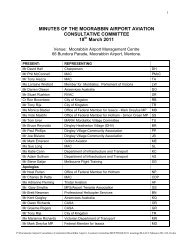Circuit Training at Moorabbin Airport Circuit Training at Moorabbin ...
Circuit Training at Moorabbin Airport Circuit Training at Moorabbin ...
Circuit Training at Moorabbin Airport Circuit Training at Moorabbin ...
Create successful ePaper yourself
Turn your PDF publications into a flip-book with our unique Google optimized e-Paper software.
6. VOLUME OF CIRCUIT TRAFFIC<br />
6.1 Moving Flying <strong>Training</strong> <strong>Circuit</strong> <strong>Training</strong>.<br />
In the course of the Taskforce’s discussions Local Councils near <strong>Moorabbin</strong> <strong>Airport</strong>, the City<br />
of Kingston and City of Gre<strong>at</strong>er Dandenong, suggested all fixed wing circuit training cease by<br />
2025 or 2030 and helicopter training cease by 2015.<br />
There are 31 aerodromes and landing grounds within 45 nautical miles of Melbourne<br />
including many oper<strong>at</strong>ed by other Local Councils. However many of these loc<strong>at</strong>ions confront<br />
the same issues as <strong>Moorabbin</strong> in terms of nearby residential areas and many do not have<br />
sufficient standard facilities or services to provide for dedic<strong>at</strong>ed flying training activities.<br />
MAC notes th<strong>at</strong> currently individual aircraft, airline and training oper<strong>at</strong>ors can determine<br />
from which airports they will oper<strong>at</strong>e. These decisions are based on a range of economic,<br />
business and oper<strong>at</strong>ional factors. Aircraft oper<strong>at</strong>ors must also meet relevant safety and<br />
oper<strong>at</strong>ional standards pertaining to their specific type of oper<strong>at</strong>ion whether it be for major<br />
regular passenger transport or for flying training.<br />
Over time p<strong>at</strong>terns of oper<strong>at</strong>ions have developed in the Melbourne region whereby<br />
Tullamarine has become the major intern<strong>at</strong>ional and domestic airport, Avalon and Essendon<br />
have a mix of traffic including some domestic and intrast<strong>at</strong>e passenger services, and airports<br />
such as <strong>Moorabbin</strong> have become important centres for flying training.<br />
Proposals to shift training activity out of <strong>Moorabbin</strong> clearly raise fundamental economic and<br />
legal issues. Aircraft oper<strong>at</strong>ors have existing contractual and sub‐lease agreements with<br />
MAC.<br />
Reloc<strong>at</strong>ion of oper<strong>at</strong>ions inevitably raises potentially significant cost and viability issues for<br />
the training industry. For example the introduction of a new flight training facility would<br />
require dedic<strong>at</strong>ed infrastructure, and the loc<strong>at</strong>ion would have to be able to <strong>at</strong>tract and<br />
retain flying instructors and local and overseas students. Therefore any proposals to<br />
consider moving flying circuit training out of <strong>Moorabbin</strong> are likely to revolve around some<br />
form of broader, long term St<strong>at</strong>e planning approach whereby particular Victorian loc<strong>at</strong>ions<br />
where developed as training airports preferably free or rel<strong>at</strong>ively free of impacts on<br />
surrounding communities, particularly residential areas.<br />
In this context, responding to community and Local Council proposals, MAC suggests a<br />
longer term review <strong>at</strong> the future of avi<strong>at</strong>ion oper<strong>at</strong>ions in Melbourne and regional Victoria,<br />
particularly rel<strong>at</strong>ed to the flying training industry. In this context measures to encourage<br />
r<strong>at</strong>her than forcing flight training re‐loc<strong>at</strong>ions might be examined including establishing<br />
training airports based in less popul<strong>at</strong>ed Melbourne or regional loc<strong>at</strong>ions.<br />
This approach is consistent with previously expressed views from the Victorian Government<br />
outlining their support of avi<strong>at</strong>ion training in Melbourne and surrounds and the need to<br />
manage avi<strong>at</strong>ion capacity in an integr<strong>at</strong>ed way across jurisdictions.<br />
Recommend<strong>at</strong>ion 7: The relevant Victorian Government agency, in consult<strong>at</strong>ion with the<br />
Federal Department of Infrastructure and Transport, undertake a review of the future<br />
avi<strong>at</strong>ion needs of Melbourne and regional Victoria, with particular emphasis on the pilot<br />
and helicopter training industries.<br />
18




